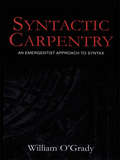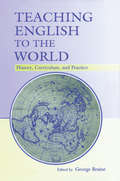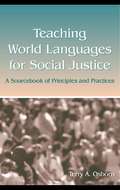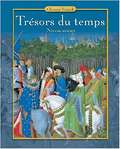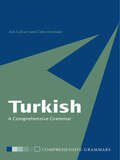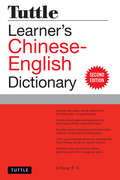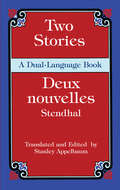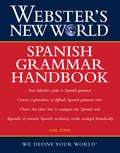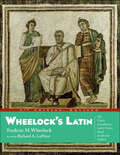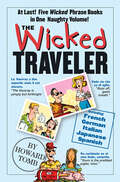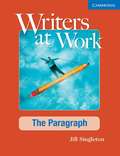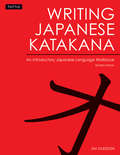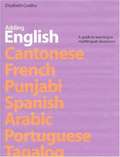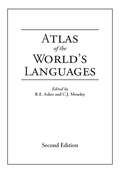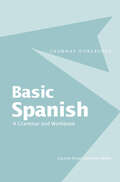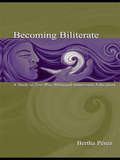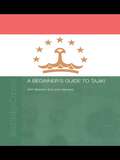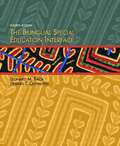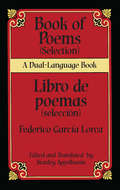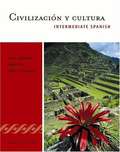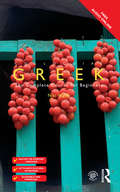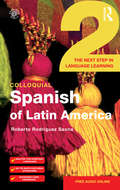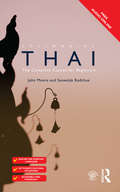- Table View
- List View
Syntactic Carpentry: An Emergentist Approach to Syntax
by William O'GradySyntactic Carpentry: An Emergentist Approach to Syntax presents a groundbreaking approach to the study of sentence formation. Building on the emergentist thesis that the structure and use of language is shaped by more basic, non-linguistic forces—rather than by an innate Universal Grammar—William O'Grady shows how the defining properties of various core syntactic phenomena (phrase structure, co-reference, control, agreement, contraction, and extraction) follow from the operation of a linear, efficiency-driven processor. This in turn leads to a compelling new view of sentence formation that subsumes syntactic theory into the theory of sentence processing, eliminating grammar in the traditional sense from the study of the language faculty. With this text, O'Grady advances a growing body of literature on emergentist approaches to language, and situates this work in a broader picture that also includes attention to key issues in the study of language acquisition, psycholinguistics, and agrammaticism. This book constitutes essential reading for anyone interested in syntax and its place in the larger enterprise of cognitive science.
Teaching English to the World: History, Curriculum, and Practice
by George BraineTeaching English to the World: History, Curriculum, and Practice is a unique collection of English language teaching (ELT) histories, curricula, and personal narratives from non-native speaker (NNS) English teachers around the world. No other book brings such a range of international ELT professionals together to describe and narrate what they know best.The book includes chapters from Brazil, China, Germany, Hong Kong, Hungary, India, Indonesia, Israel, Japan, Lebanon, Poland, Saudi Arabia, Singapore, Sri Lanka, and Turkey. All chapters follow a consistent pattern, describing first the history of English language teaching in a particular country, then the current ELT curriculum, followed by the biography or the autobiography of an English teacher of that country. This consistency in the structuring of chapters will enable readers to assimilate the information easily while also comparing and contrasting the context of ELT in each country.The chapter authors--all born in or residents of the countries they represent and speakers of the local language or languages as well as English--provide insider perspectives on the challenges faced by local English language teachers. There is clear evidence that the majority of English teachers worldwide are nonnative speakers (NNS), and there is no doubt that many among them have been taught by indigenous teachers who themselves are nonnative speakers. This book brings the professional knowledge and experience of these teachers and the countries they represent to a mainstream Western audience including faculty, professionals, and graduate students in the field of ESL; to the international TESOL community; and to ELT teachers around the world.
Teaching World Languages for Social Justice: A Sourcebook of Principles and Practices
by Terry A. OsbornTeaching World Languages for Social Justice: A Sourcebook of Principles and Practices offers principles based on theory, and innovative concepts, approaches, and practices illustrated through concrete examples, for promoting social justice and developing a critical praxis in foreign language classrooms in the U.S. and in wider world language communities. For educators seeking to translate these ideals into classroom practice in an environment dominated by the current standards movement and accountability measures, the critical insights on language education offered in this text will be widely welcomed.The text is designed as a sourcebook for translating theory into practice. Each chapter includes the theoretical base, guidelines for practice, discussion of the relationship to existing practices in the world language classroom, suggestions for activity development (which can be integrated into a professional portfolio), illustrative examples, questions for reflection, and additional suggested readings.Teaching World Languages for Social Justice is a primary or supplementary text for second and foreign language teaching methods courses and is equally appropriate for graduate courses in language education or educational studies.
Turkish: A Step-by-step Approach For Chemical Engineers (Routledge Comprehensive Grammars)
by Aslı Göksel Celia KerslakeTurkish: A Comprehensive Grammar is a complete reference guide to modern Turkish grammar. Concentrating on the real patterns of use in modern Turkish, it presents a detailed and systematic description of the structure of language at every level:sounds, words and sentences and will remain the standard reference work for years to come. Drawing upon a rapidly growing body of scholarly research on Turkish, this well-presented Grammar is a stimulating and up-to-date analysis of the complexities of the language, with full and clear explanations and examples throughout. A detailed index and extensive cross-referencing between numbered subsections also provides readers with easy access to the information they require. Features include: detailed treatment of common grammatical structures and parts of speech extensive use of examples, all with English translations particular attention to areas of confusion and difficulty comprehensive glossary of all grammatical terms. The Grammar is an essential reference source for intermediate and advanced learners and users of Turkish. It is ideal for use in schools, colleges, universities and adult classes of all types.
Tuttle Learner's Chinese-English Dictionary: Revised Second Edition
by Li DongThis Mandarin Chinese Dictionary is for elementary to intermediate learners of Chinese.Tuttle Learner's Chinese-English Dictionary is a totally new dictionary designed specifically for elementary to intermediate learners of Chinese, and contains all 3,051 vocabulary items prescribed for Levels A and B of the internationally recognized test of Mandarin language proficiency, Hanyu Shuiping Kaoshi (HSK).<P><P>This self-contained dictionary has over 3,000 headwords-those required for HSK Levels A and B, plus important proper nouns and common idioms. Extensive notes on culture, grammar and meaning are included to enhance understanding and ensure correct usage. Students attempting to learn Chinese will find this dictionary to be an essential guide to the Chinese language as well as a reliable reference tool.This Chinese dictionary contains: The 4,800 most frequently used Chinese vocabulary items. All entries contain Romanized Chinese forms (hanyu pinyin), simplified Chinese characters (hanzi) as well as traditional Chinese characters if they exist. Terms are searchable by Chinese-English or English-Chinese. All Chinese entries are arranged alphabetically by Romanized Mandarin Chinese forms (hanyu pinyin). Chinese word components are listed and analyzed to facilitate understanding. Over 4,700 sample sentences to demonstrate how each word is used. Detailed notes on culture, grammar and usage. Chinese translations for common English names and places in China.
Two Stories/Deux nouvelles: A Dual-Language Book
by Stendhal Stanley AppelbaumIn writing these two ardently romantic and turbulent tales, Stendhal delved deep into old Italian narratives and into his own impassioned heart. "Vanina Vanini" and "L'abbesse de Castro" abound in the qualities for which the French author remains enduringly popular: his strong-willed, impulsive characters; his dry wit and keen irony; and the sweeping drama of his historical settings. Originally published in the Revue de Paris in 1829, "Vanina Vanini" traces the fortunes of an aristocrat's daughter who falls in love with a wounded soldier, and prefigures Stendhal's superb novel, The Red and the Black, which appeared two years later. "L'abbesse de Castro," published in 1839 under a pseudonym in the prestigious Revue des Deux Mondes, was reputedly derived from Roman and Florentine source manuscripts. Consisting chiefly of Stendhal's own invention, it recounts the illicit liaison and subsequent trial of an abbess.The only dual-language edition of these stories, this book features an informative introduction and ample footnotes, making it not only a pleasure to read but also a valuable learning and teaching aid for students and teachers of French literature.
Webster's New World: Spanish Grammar Handbook (Webster's New World)
by Gail SteinThis definitive guide to Spanish grammar covers all aspects of spoken and written Spanish from essential vocabulary to tense and mood conjugations. Webster&’s New World: Spanish Grammer Handbook is an essential resource for any Spanish language learner. Divided into fifteen chapters, it covers everything from basic necessities such as numbers, dates, and weather, to more complex forms of expression such as comparisons, idioms, and the subjunctive mood. Covering vocabulary, conjugation, tenses, moods, and much more, this complete guide will help you hone your Spanish speaking and writing skills. Organized so you can proceed at your own pace and review as needed, Webster's New World Spanish Grammar Handbook helps you progress from vocabulary to proficiency so you can communicate confidently in both social and business situations.
Wheelock's Latin: The Classic Introductory Latin Course, Based on Ancient Authors
by Frederic M. WheelockThe classic, single–volume introductory Latin textbook, introduced in 1956 and still the bestselling and most highly regarded textbook of its kind. Wheelock's Latin, sixth edition, revised, has all the features that have made it the best–selling single–volume beginning Latin textbook, many of them revised and expanded: o 40 chapters with grammatical explanations and readings based on ancient Roman authors o Self–tutorial exercises with an answer key for independent study o An extensive English–Latin/ Latin–English vocabulary section o A rich selection of original Latin readings –– unlike other textbooks which contain primarily made–up Latin texts o Etymological aids Also includes maps of the Mediterranean, Italy and the Aegean area, as well as numerous photographs illustrating aspects of classical culture, mythology, and historical and literary figures presented in the chapter readings. o The leading self–tutorial Latin program. Also great for college and accelerated high school courses. o Wheelock's Latin is the top–selling Latin reference in the US. o Interest and enrolments in Latin have been steadily rising in the U.S. for the past 20 years. One–half million people are currently enrolled in Latin classes, and at least 10,000 teachers, professors and graduate assistants are teaching the language in America.
The Wicked Traveler: 8-copy Counter Display (Wicked Travel Ser.)
by Howard Tomb<P>Respond to Japanese Noh theater like a native: Kazoku sorrote no seppuku ga yokatta. (“I love the part where the whole family disembowels themselves.”) <P>Speak to homicidal Parisian taxi drivers in a language they’ll understand: Ou avez-vous appris à conduire? <P>En Italie? (“Where did you learn to drive? Italy?”) <P>Discuss Italian olive oil with the proper degree of reverence: Un assaggio ti dice che le olive sono maturate di fronte ad una cattedrale. (“One taste tells you the olives grew in full view of the cathedral.”) <P>Establish privacy needs in Mexico: Preferiría una habitación sin alacranes. (“I’d prefer a room without scorpions.”) <P>With seven titles and over 1.2 million copies in print, Howard Tomb’s Wicked phrase book series is the fiendishly irreverent—and very successful—collection that gives travelers the words they wish they could utter while, say, attempting to find the exit of the Louvre or facing a plate of fugu (poisonous blowfish) in Japan. Now, the five most popular Wicked books—Italian, French, Japanese, German, and Spanish— have been updated and compiled into The Wicked Traveler. <P>Because, as Howard Tomb writes in his new introduction: “Every country is different, but all foreign places have one thing in common: they’re weird.”
Writers at Work: The Paragraph
by Jill SingletonThe Writers at Work series prepares ESL students to tackle academic essay writing. Writers at Work: The Paragraph is designed for high-beginning to low-intermediate writing students. It uses personal topics such as "A Person Important to You" and "Holidays" to teach the basics of paragraph writing. A five-step process approach teaches students how to generate ideas, write a first draft, revise, edit, and self-evaluate their writing.
Writing Japanese Katakana
by Jim GleesonThis is an introductory guide and workbook to writing Japanese Katakana.Anybody who is able to master English, with its irregular spellings and idiosyncratic pronunciations, is more than equipped to master written Japanese. The hiragana and katakana syllabaries are purely phonetic characters, which function much like the letters of the English alphabet. In this respect, kana are quite different from kanji characters, which are based on Chinese ideographs and which represent ideas. The katakana syllabary is used primarily to represent borrowed words (from languages other than Chinese), although it is also used for botanical names and is sometimes used in place of hiragana or kanji for emphasis. In some ways, the use of katakana in Japanese parallels the use of italics in English.Writing practice is the most effective method of mastering written Japanese, and the large open format of this workbook is designed to invite the student to pick up a pencil and start writing. Written Japanese comprises two phonetic syllabaries, hiragana and katakana, and a set of kanji characters that are based on Chinese ideographs. This workbook has been carefully designed to facilitate the quick and easy mastery of the 46-character katakana alphabet, making it the perfect tool to begin the process of mastering written Japanese. Each character is introduced with brushed, handwritten and typed samples that enhance character recognition. Extensive space for writing allows maximum practice to facilitate memorization and to ensure proper character formation. Entertaining illustrations and amusing examples of loan-words that use katakana in Japanese writings further reinforce memorization in a fun way. Writing Katakana is tailored to the specific needs of young students of the Japanese language, but is also well suited to beginning students of any age. This workbook contains:grayed-out, trace-over characters for correct character constructionExtensive practice in writing sentences for maximum reinforcementSupplementary explanations, including a brief history of the origin of each character, to foster visual recall.
Writing Japanese Katakana
by Jim GleesonThis is an introductory guide and workbook to writing Japanese Katakana.Anybody who is able to master English, with its irregular spellings and idiosyncratic pronunciations, is more than equipped to master written Japanese. The hiragana and katakana syllabaries are purely phonetic characters, which function much like the letters of the English alphabet. In this respect, kana are quite different from kanji characters, which are based on Chinese ideographs and which represent ideas. The katakana syllabary is used primarily to represent borrowed words (from languages other than Chinese), although it is also used for botanical names and is sometimes used in place of hiragana or kanji for emphasis. In some ways, the use of katakana in Japanese parallels the use of italics in English.Writing practice is the most effective method of mastering written Japanese, and the large open format of this workbook is designed to invite the student to pick up a pencil and start writing. Written Japanese comprises two phonetic syllabaries, hiragana and katakana, and a set of kanji characters that are based on Chinese ideographs. This workbook has been carefully designed to facilitate the quick and easy mastery of the 46-character katakana alphabet, making it the perfect tool to begin the process of mastering written Japanese. Each character is introduced with brushed, handwritten and typed samples that enhance character recognition. Extensive space for writing allows maximum practice to facilitate memorization and to ensure proper character formation. Entertaining illustrations and amusing examples of loan-words that use katakana in Japanese writings further reinforce memorization in a fun way. Writing Katakana is tailored to the specific needs of young students of the Japanese language, but is also well suited to beginning students of any age. This workbook contains:grayed-out, trace-over characters for correct character constructionExtensive practice in writing sentences for maximum reinforcementSupplementary explanations, including a brief history of the origin of each character, to foster visual recall.
Yapese Alphabet (Island Alphabet Books)
by Lori PhillipsThis book is part of the Island Alphabet Books series, which features languages and children's artwork from the U.S.-affiliated Pacific. Each book contains the complete alphabet for the language, four or five examples for each letter, and a word list with English translations. The series is published by PREL, a non- profit corporation that works collaboratively with school systems to enhance education across the Pacific.
Adding English: A Guide to Teaching in Multilingual Classrooms
by Elizabeth CoelhoAdding English: A Guide to Teaching in Multilingual Classrooms is a comprehensive source of ideas of advice for enhancing the learning of all students in all subject areas and at all grade levels.
Atlas of the World's Languages: Context And Process (Memory Of Peoples Ser.)
by R. E. Asher and Christopher MoseleyBefore the first appearance of the Atlas of the World's Languages in 1993, all the world's languages had never been accurately and completely mapped. The Atlas depicts the location of every known living language, including languages on the point of extinction. This fully revised edition of the Atlas offers: up-to-date research, some from fieldwork in early 2006 a general linguistic history of each section an overview of the genetic relations of the languages in each section statistical and sociolinguistic information a large number of new or completely updated maps further reading and a bibliography for each section a cross-referenced language index of over 6,000 languages. Presenting contributions from international scholars, covering over 6,000 languages and containing over 150 full-colour maps, the Atlas of the World's Languages is the definitive reference resource for every linguistic and reference library.
Basic Spanish: A Grammar and Workbook (Grammar Workbooks)
by Irene Wilkie Carmen ArnaizPresenting twenty individual grammar points in lively and realistic contexts, Basic Spanish is an accessible reference grammar with related exercises in one, easy to follow volume. Beginning with the simpler aspects of Spanish and progressing on to more complex areas, each chapter contains grammar points that are followed by examples and exercises selected to reinforce the topic. A first-class introduction to the language, features of this practical book include: * authentic reading texts to encourage an understanding of Spain and Spanish-speaking countries * reference to Latin American usage where appropriate * abundant exercises with full answer key * glossary of grammatical terms. Clearly presented and user-friendly, Basic Spanish provides readers with the basic tools to express themselves in a wide variety of situations, making it an ideal reference and practice resource for both beginners and students with some knowledge of the language.
Becoming Biliterate: A Study of Two-Way Bilingual Immersion Education
by Bertha PerezThis book describes the development process and dynamics of change in the course of implementing a two-way bilingual immersion education program in two school communities. The focus is on the language and literacy learning of elementary-school students and on how it is influenced by parents, teachers, and policymakers. Pérez provides rich, highly detailed descriptions, both quantitative and qualitative, of the change process at the two schools involved, including student language and achievement data for five years of program implementation that were used to test the basic two-way bilingual theory, the specific school interventions, and the particular classroom instructional practices. The contribution of Becoming Biliterate: A Study of Two-Way Bilingual Immersion Education is to provide a comprehensive description of contextual and instructional factors that might help or hinder the attainment of successful literacy and student outcomes in both languages. The study has broad theoretical, policy, and practical instructional relevance for the many other U.S. school districts with large student populations of non-native speakers of English. This volume is highly relevant for researchers, teacher educators, and graduate students in bilingual and ESL education, language policy, linguistics, and language education, and as a text for master's- and doctoral-level classes in these areas.
A Beginners' Guide to Tajiki
by Azim Baizoyev John HaywardThis is a conversational approach to the teaching and learning of the Tajiki language. It uses authentic language material to help learners as they proceed through its topic-based lessons. Its emphasis on the spoken language promotes oral fluency alongside written skills. Both lessons and appendices present new vocabulary and grammar simply and recycle material to provide opportunities for both controlled and free language learning.The appendices include not only lists of useful information and samples of commonly needed letters and speeches but also an invaluable introduction to Tajiki grammar and a comprehensive Tajiki-English dictionary of all the book's vocabulary - over 4500 definitions.
The Bilingual Special Education Interface
by Leonard M. Baca Hermes T. CervantesThis book offers an understanding of the major needs of bilingual children who also have disabilities. Chapters highlight the connections between the common knowledge base, programs, and methodologies of special education and those of bilingual education in order to explore the ways to help exceptional children of Asian, African, Hispanic, and Native-American heritage. Practical information is balanced with strong research. Topics include: a judicial perspective on bilingual special education; a development of the bilingual special education interface; language acquisition; issues and assessment; procedures and techniques for assessment; individualized educational programs; instructional plans and curriculum development; methods and materials; family involvement; and issues in policy development and implementation. An excellent resource for teachers, counselors, psychologists, and speech/language specialists.
Book of Poems: A Dual-Language Book (Dover Dual Language Spanish)
by Federico García Lorca Stanley AppelbaumThe passionate life and violent death of Federico Garcia Lorca (1898-1936) retain an enduring fascination for readers around the world. Murdered by Nationalists at the outset of the Spanish Civil War, Lorca died at the peak of his creative powers. He remains his country's most widely translated writer, surpassed only by Cervantes in terms of critical commentary.This selection includes 55 of the 68 poems that comprised Lorca's 1921 Libro de poemas, all of them in their entirety and in their original sequence. Imbued with the spirit and folklore of the poet's native Andalusia, these verses feature the most complex spiritual content of any of Lorca's works. Editor Stanley Appelbaum provides sensitive, accurate English translations on the pages facing the original Spanish, as well as an informative introduction to the author's life and oeuvre, plus notes on the individual poems. An outstanding resource for students and teachers of Spanish language and literature, this compilation will enchant any lover of poetry.
Civilizacion y Cultura Intermediate Spanish (8th edition)
by Lynn A. Sandstedt Ralph Kite John G. CopelandCIVILIZACION Y CULTURA, Eighth Edition, part of a complete intermediate series, offers readers twelve units that combine a thematic and historical approach which introduces students to traditional cultural topics and daily life issues found throughout the Hispanic world.
Colloquial Greek: The Complete Course For Beginners (Colloquial Ser.)
by Niki WattsColloquial Greek: The Complete Course for Beginners has been carefully developed by an experienced teacher to provide a step-by-step course to Greeceas it is written and spoken today. Combining a clear, practical and accessible style with a methodical and thorough treatment of the language, it equips learners with the essential skills needed to communicate confidently and effectively in Greek in a broad range of situations. No prior knowledge of the language is required. Colloquial Greek is exceptional; each unit presents a wealth of grammatical points that are reinforced with a wide range of exercises for regular practice. A full answer key, a grammar index and bilingual glossaries can be found at the back as well as useful vocabulary lists throughout. Key features include: A clear, user-friendly format designed to help learners progressively build up their speaking, listening, reading and writing skills Jargon-free, succinct and clearly structured explanations of grammar An extensive range of focused and dynamic supportive exercises Realistic and entertaining dialogues covering a broad variety of narrative situations Helpful cultural points explaining the customs and features of life in Greece An overview of the sounds of Greek Balanced, comprehensive and rewarding, Colloquial Greek is an indispensable resource both for independent learners and students taking courses in Greek. Audio material to accompany the course is available to download free in MP3 format from www.routledge.com/cw/colloquials. Recorded by native speakers, the audio material features the dialogues and texts from the book and will help develop your listening and pronunciation skills.
Colloquial Spanish of Latin America 2: The Next Step in Language Learning (Colloquial Ser.)
by Roberto Rodriguez-SaonaDo you know Latin American Spanish already and want to go a stage further? If you're planning a visit to South America, need to brush up your Latin American Spanish for work, or are simply doing a course, Colloquial Spanish of Latin America 2 is the ideal way to refresh your knowledge of the language and extend your skills. Colloquial Spanish of Latin America 2 is designed to help those involved in self-study. Structured to give you the opportunity to listen to and read lots of modern, everyday Latin American Spanish, it has been developed to work systematically on reinforcing and extending your grasp of the grammar and vocabulary. Key features of Colloquial Spanish of Latin America 2 include: Revision material to help consolidate and build up your basics Lots of spoken and written exercises in each unit A grammar reference and detailed answer keys Extensive Spanish/English and English/Spanish glossaries Audio material to accompany the course is available to download free in MP3 format from www.routledge.com/cw/colloquials. Recorded by native speakers, the audio material features the dialogues and texts from the book and will help develop your listening and pronunciation skills.
Colloquial Thai: The Complete Course For Beginners (Colloquial Ser.)
by John Moore Saowalak RodchueColloquial Thai: The Complete Course for Beginners has been carefully developed by an experienced teacher to provide a step-by-step course to Thai as it is written and spoken today. Combining a clear, practical and accessible style with a methodical and thorough treatment of the language, it equips learners with the essential skills needed to communicate confidently and effectively in Thai in a broad range of situations. No prior knowledge of the language is required. Colloquial Thai is exceptional; each unit presents a wealth of grammatical points that are reinforced with a wide range of exercises for regular practice. A full answer key, a grammar summary, bilingual glossaries and English translations of dialogues can be found at the back as well as useful vocabulary lists throughout. Key features include: A clear, user-friendly format designed to help learners progressively build up their speaking, listening, reading and writing skills Jargon-free, succinct and clearly structured explanations of grammar An extensive range of focused and dynamic supportive exercises Realistic and entertaining dialogues covering a broad variety of narrative situations Helpful cultural points explaining the customs and features of life in Thailand. An overview of the sounds of Thai Balanced, comprehensive and rewarding, Colloquial Thai is an indispensable resource both for independent learners and students taking courses in Thai. Audio material to accompany the course is available to download free in MP3 format from www.routledge.com/cw/colloquials. Recorded by native speakers, the audio material features the dialogues and texts from the book and will help develop your listening and pronunciation skills.
